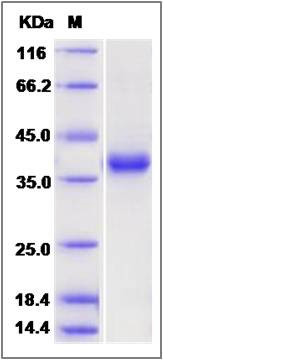Human Glutaminyl cyclase / QPCT Protein (His Tag)
GCT,QC,sQC
- 100ug (NPP1302) Please inquiry
| Catalog Number | P13752-H07B |
|---|---|
| Organism Species | Human |
| Host | Baculovirus-Insect Cells |
| Synonyms | GCT,QC,sQC |
| Molecular Weight | The recombinant human QPCT consists of 345 amino acids and has a calculated molecular mass of 39.7 kDa. The recombinant protein migrates as an approximately 38 kDa band in SDS-PAGE under reducing conditions. |
| predicted N | His |
| SDS-PAGE |  |
| Purity | > 95 % as determined by SDS-PAGE |
| Protein Construction | A DNA sequence encoding the human QPCT (Q16769-1) (Ala33-Leu361) was fused with a polyhistide tag at the N-terminus. |
| Bio-activity | |
| Research Area | Neuroscience |Neurotransmitter |Amino Acids |
| Formulation | Lyophilized from sterile 20mM Tris, 500mM NaCl, pH 7.4, 10% gly 1. Normally 5 % - 8 % trehalose and mannitol are added as protectants before lyophilization. Specific concentrations are included in the hardcopy of COA. |
| Background | Glutaminyl cyclase, also known as QPCT, can promote the N-terminal cyclization reaction of N-terminal pyroglutamate(pGlu). The pGlu formation from its glutaminyl precursor is required in the maturation of numerous bioactive peptides, while the aberrant formation of pGlu may be related to several pathological processes, such as osteoporosis and amyloidotic diseases. Glutaminyl cyclase's structure reveals an alpha/beta scaffold akin to that of two-zinc exopeptidases but with several insertions and deletions, particularly in the active-site region. Glutaminyl cyclase's amino acid sequence of this enzyme is 86% identical to that of bovine glutaminyl cyclase. It is responsible for the presence of pyroglutamyl residues in many neuroendocrine peptides. |
| Reference |
